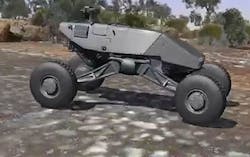Leidos eyes technologies for stealthy vetronics able to hide combat vehicles from sensors
Officials of the U.S. Defense Advanced Research Projects Agency (DARPA) in Arlington, announced a $2.2 million contract to Leidos this week for the advanced signature management portion of the DARPA Ground X-Vehicle Technologies (GXV-T) program.
The DARPA GXV-T program seeks to develop technologies to enable future armored combat vehicles to protect themselves not with armor, but instead with speed, agility, and stealth.
DARPA scientists are interested in developing technologies to enable future combat vehicles to travel as fast as 75 miles per hour over open terrain while avoiding enemy fire through speed, agility, crew automation, and low visibility.
Related: Emerging vetronics standards aim to spell VICTORY for tomorrow's combat vehicles
The idea is to reduce the need for heavy armor on combat vehicles that slows them down, makes them heavier and less maneuverable, requires big inefficient engines, and leaves them vulnerable to advanced anti-tank weapons and sensors.
story continues below
Leidos will tackle these challenges by reducing the ability of electro-optical sensors, microphones, radar, and the human eye to detect the presence of combat vehicles -- even while the vehicles are maneuvering quickly over open country in broad daylight. The reduction of vehicle signatures may enhance survivability with a lower weight penalty than armor, DARPA researchers point out.
Specifically, Leidos experts will try to find ways for vehicles to hide from infrared and visible-light sensors, radar, and microphones. Leidos also will try to find ways of reducing or hiding dust clouds that moving armored vehicles generate, as well as hiding a vehicle's tracks on the ground.
Related: Upgrading combat vehicles with versatile vetronics
Reducing the signature of ground vehicles could result in lower probabilities detection and attack, DARPA officials say. In a combat situation, vehicles with lower signatures also might develop a tactical advantage through a longer effective standoff range.
The overall goal of Leidos researchers is to find enabling technologies to render armored combat vehicles harder to detect; harder to identify and classify; harder to track; harder to engage; and harder for the enemy to hit.
For more information contact Leidos online at www.leidos.com, or DARPA at www.darpa.mil.
